Stacking Fear
There is a massive new real estate project quietly rooting itself along the U.S./Mexico border just south of San Ysidro where San Diego and Tijuana officially share a border crossing – the busiest in the world, by the way. While it is not exactly a border fence its ultimate effect I imagine going on to serve just as much the same once it is completed and persists in its lifetime. It is I think a wall by another means, if you'll excuse my skepticism.
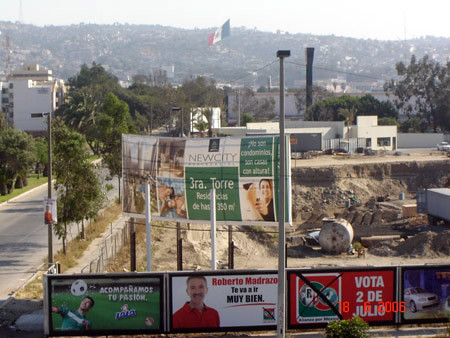
After all, were talking about one of the world’s richest cities neighboring one of the world’s poorest. Nowhere else can the economic disparity between two nations, within just a few miles reach of one another, nonetheless, be made more visible. Nor, I suppose, can we expect that any construction along the border at this scale would not somehow serve as a sort of de facto barrier, given the conservative political climate right now and its dismal depiction of the border.
And if all continues to go according to developer Moisés Abadi’s plan, it will end up being the tallest set of structures not just on the border, but in all of Tijuana. A new epic landmark to be sure.
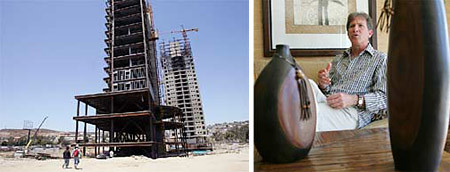
“New City”, as the project is unsurprisingly called, is a cluster of seven 25-story tall condominium towers currently rising less than a mile south of the border in Tijuana's Zona Río neighborhood. You could say they are high-rise resorts for the “crime-weary middle-and upper-income buyers who can't – or don't want to – move across the border to San Diego,” as one writer for the Union Tribune has put it. In this case, it’s probably just as accurate to say – instead of going to San Diego, San Diego has come to them.
Essentially, it is a massive urban gated community boasting 500 units with access to luxurious swimming pools and private tennis courts, unique business spaces and hotel-like sky lounges with views of downtown San Diego, the bay, and the Pacific Ocean. It goes without saying, of course, that New City will also provide protected parking and an 11-foot-high wall encircling the entire 7.5-acre privatopia, its own network of video surveillance cameras, special electronic passes for residents, and the usual suspects of round-the-clock security guards.
Could this be a new form of border zone panopticon? The urban vertical gated community?
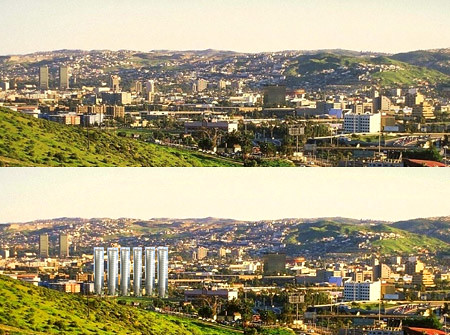
In the end, I wonder if these towers, which will redefine the Tijuana skyline, will open up to a more affordable spread of housing development, or just preside by themselves there over the 2.5m people living in TJ like a new set of fortress gates further enforcing the barriers of geo-economic exclusion that quintessentially defines the space between the U.S. and Mexico.
Even though Abadi is a Mexico-based developer the clients are just the type of mix you’d expect, and “range from retirees looking to simplify their lives, to cross-border businessmen searching for a pied-à-terre, to young families starting out, to anyone who can afford units selling from $150,000 to nearly $800,000. San Diegans looking to lower their housing costs have also been buying.”
It all adds to the complex and intricate joint flows of migration that occur between the two nations, as more and more money from both sides of the border begin to move back and forth, resettle and huddle along the border in oddly reciprocal and ironic geographic shifts. Mostly all you hear about is the great burden of Latin immigration to the U.S., but rarely enough about the opposite droves of retired American couples pouring down south to buy up vast swaths of Mexican real estate – just look at the incredible gringo squat that is the Baja peninsula.
Even if New City houses a middle/upper class mix of Mexican residents, the convergence of all these different populations from both countries on the border and ultimately how the border is being planned and constructed fascinates me. The towers are really just giant stacks of money mostly bridging an upper class exodus from Mexico City with the moneyed highways of commerce running in all directions through out San Diego, pressurizing the nexus of one of the busiest and already most economically polarized borders in the world.
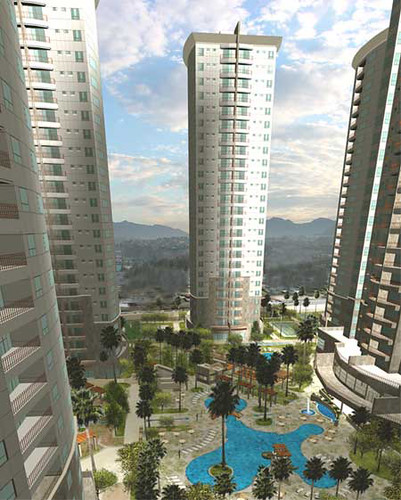
And the developer makes no qualms about catering and capitalizing off of the main impetus for this new housing trend in Tijuana, either. The San Diego Reader reported last year how increased kidnappings of upper society people in both Mexico City and Tijuana have opened up new movement patterns and security businesses.
And so, as you would suspect, these residential fortresses are starting to pop up left and right in Tijuana. From the same news sources we learn that “Tijuana first went vertical in 1982, with the completion of the 295-foot Agua Caliente towers, now a well-known emblem of the city.” But, New City will surpass that milestone. In addition, “Mexico City-based Keco, is investing $21 million in a tower overlooking the golf course of Tijuana's Club Campestre” – known as the Green View Towers. And “in Colinas de Agua Caliente, developer Luis Mario Islas' company, Habitamex, is planning Bosque de Agua Caliente, a gated community aimed at upper-middle-income buyers.”
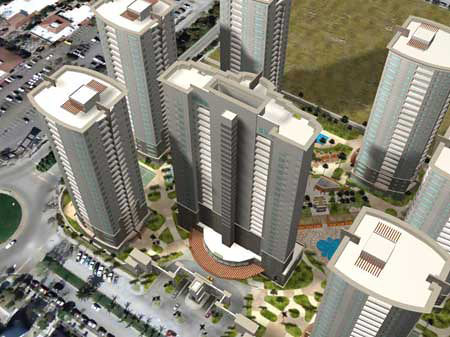
Maybe all of this just represents a greater growth pattern in what is cementing the larger global divide – altogether, in essence, defining the defensive outline of a global “wall of capital”, as Mike Davis would call it.
But, particularly interesting to me is how border real estate itself is devised, by what collisions of formal and informal space? The spatial politics of the border exists in such a matrix of contrasting layers and opposing landscapes; from a pervasive para-militarism to the unarmed huddle of millions of impoverished people, from more natural bi-national boundaries like the Rio Grande to the blatant NAFTA-induced pollution disasters that riddle the southern borders of Texas and California where maquiladoras get away with environmental murder, from rampant gentrification in certain pockets to the overall absence of any real urban planning at all - where condominiums are surrogate border walls and the border wall itself becomes an architectural form of detention.
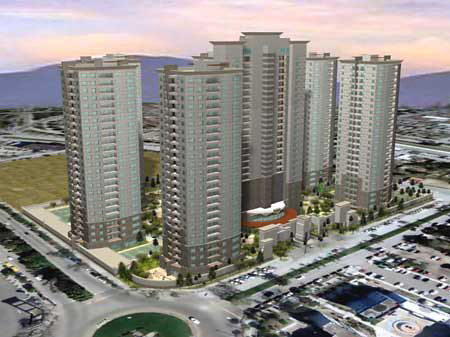
It’s as if all of the forces and counter-forces of globalization converge on the border to constitute the ultimate geopolitical fortification, through some indiscernible spatial logic that organizes the physical dimensions of free trade, national security, selective migration, and different forms of civilian occupation into a single border space. I mean let’s face it, this isn’t the contrasting typology of a future global urban landscape, this is the present complexion: fundamentally distilled into gated communities that soar in the air, checkpoints and border fences, and an immeasurable expanse of favelas tumbling over the landscape.
In the end, what if the border becomes completely lined with these towers, side by side - a run-on wall of towers - altogether creating the world's longest as well as tallest gated community, as Teddy Cruz might remark? That would be freaky. Not sure any ladders would be able to hop that fence.
Talk about uneven capitalist development.
[All images of the project New City via www.tienetodo.com. For all you lucky spanish speakers out there, here are some additional disscussions to check out on SkyscraperCity (1 & 2).] (Story via Planetizen)

After all, were talking about one of the world’s richest cities neighboring one of the world’s poorest. Nowhere else can the economic disparity between two nations, within just a few miles reach of one another, nonetheless, be made more visible. Nor, I suppose, can we expect that any construction along the border at this scale would not somehow serve as a sort of de facto barrier, given the conservative political climate right now and its dismal depiction of the border.
And if all continues to go according to developer Moisés Abadi’s plan, it will end up being the tallest set of structures not just on the border, but in all of Tijuana. A new epic landmark to be sure.

“New City”, as the project is unsurprisingly called, is a cluster of seven 25-story tall condominium towers currently rising less than a mile south of the border in Tijuana's Zona Río neighborhood. You could say they are high-rise resorts for the “crime-weary middle-and upper-income buyers who can't – or don't want to – move across the border to San Diego,” as one writer for the Union Tribune has put it. In this case, it’s probably just as accurate to say – instead of going to San Diego, San Diego has come to them.
Essentially, it is a massive urban gated community boasting 500 units with access to luxurious swimming pools and private tennis courts, unique business spaces and hotel-like sky lounges with views of downtown San Diego, the bay, and the Pacific Ocean. It goes without saying, of course, that New City will also provide protected parking and an 11-foot-high wall encircling the entire 7.5-acre privatopia, its own network of video surveillance cameras, special electronic passes for residents, and the usual suspects of round-the-clock security guards.
Could this be a new form of border zone panopticon? The urban vertical gated community?

In the end, I wonder if these towers, which will redefine the Tijuana skyline, will open up to a more affordable spread of housing development, or just preside by themselves there over the 2.5m people living in TJ like a new set of fortress gates further enforcing the barriers of geo-economic exclusion that quintessentially defines the space between the U.S. and Mexico.
Even though Abadi is a Mexico-based developer the clients are just the type of mix you’d expect, and “range from retirees looking to simplify their lives, to cross-border businessmen searching for a pied-à-terre, to young families starting out, to anyone who can afford units selling from $150,000 to nearly $800,000. San Diegans looking to lower their housing costs have also been buying.”
It all adds to the complex and intricate joint flows of migration that occur between the two nations, as more and more money from both sides of the border begin to move back and forth, resettle and huddle along the border in oddly reciprocal and ironic geographic shifts. Mostly all you hear about is the great burden of Latin immigration to the U.S., but rarely enough about the opposite droves of retired American couples pouring down south to buy up vast swaths of Mexican real estate – just look at the incredible gringo squat that is the Baja peninsula.
Even if New City houses a middle/upper class mix of Mexican residents, the convergence of all these different populations from both countries on the border and ultimately how the border is being planned and constructed fascinates me. The towers are really just giant stacks of money mostly bridging an upper class exodus from Mexico City with the moneyed highways of commerce running in all directions through out San Diego, pressurizing the nexus of one of the busiest and already most economically polarized borders in the world.

And the developer makes no qualms about catering and capitalizing off of the main impetus for this new housing trend in Tijuana, either. The San Diego Reader reported last year how increased kidnappings of upper society people in both Mexico City and Tijuana have opened up new movement patterns and security businesses.
Two years ago, Total Shield, an automobile-armoring business from Mexico City, opened an office in Tijuana. Fear of kidnapping and carjacking fuels the business they've been doing since. Abadi feels the same fear of crime will help him sell another Mexico City concept to Tijuanenses.
And so, as you would suspect, these residential fortresses are starting to pop up left and right in Tijuana. From the same news sources we learn that “Tijuana first went vertical in 1982, with the completion of the 295-foot Agua Caliente towers, now a well-known emblem of the city.” But, New City will surpass that milestone. In addition, “Mexico City-based Keco, is investing $21 million in a tower overlooking the golf course of Tijuana's Club Campestre” – known as the Green View Towers. And “in Colinas de Agua Caliente, developer Luis Mario Islas' company, Habitamex, is planning Bosque de Agua Caliente, a gated community aimed at upper-middle-income buyers.”

Maybe all of this just represents a greater growth pattern in what is cementing the larger global divide – altogether, in essence, defining the defensive outline of a global “wall of capital”, as Mike Davis would call it.
But, particularly interesting to me is how border real estate itself is devised, by what collisions of formal and informal space? The spatial politics of the border exists in such a matrix of contrasting layers and opposing landscapes; from a pervasive para-militarism to the unarmed huddle of millions of impoverished people, from more natural bi-national boundaries like the Rio Grande to the blatant NAFTA-induced pollution disasters that riddle the southern borders of Texas and California where maquiladoras get away with environmental murder, from rampant gentrification in certain pockets to the overall absence of any real urban planning at all - where condominiums are surrogate border walls and the border wall itself becomes an architectural form of detention.

It’s as if all of the forces and counter-forces of globalization converge on the border to constitute the ultimate geopolitical fortification, through some indiscernible spatial logic that organizes the physical dimensions of free trade, national security, selective migration, and different forms of civilian occupation into a single border space. I mean let’s face it, this isn’t the contrasting typology of a future global urban landscape, this is the present complexion: fundamentally distilled into gated communities that soar in the air, checkpoints and border fences, and an immeasurable expanse of favelas tumbling over the landscape.
In the end, what if the border becomes completely lined with these towers, side by side - a run-on wall of towers - altogether creating the world's longest as well as tallest gated community, as Teddy Cruz might remark? That would be freaky. Not sure any ladders would be able to hop that fence.
Talk about uneven capitalist development.
[All images of the project New City via www.tienetodo.com. For all you lucky spanish speakers out there, here are some additional disscussions to check out on SkyscraperCity (1 & 2).] (Story via Planetizen)







5 Comments:
Yes, New City is a vertical gated community in the likes of development in Mission Valley during the 70s in San Diego. The development is located AT the border Tijuana side, in La Linea a place that creates 50% of the air pollution in Tijuana from auto emissions waiting to cross to San Diego. Its shame that developments like this one focus on “fear” as a selling slogan. There are so many interesting communities near the border area - shouting for redevelopment projects, of 5 to 6 story buildings max, that would engage the urban fabric of the city and nearby downtown. Tijuana compared to San Diego is a poor city, but not the poorest; on the contrary it has the country’s lowest unemployment rate. Tijuana needs to retake its streets building by building and block by block and someone should council these Chilango investors on the benefits of redevelopment in traditional neighborhoods, ALL the people of Tijuana deserve it.
thanks rene for that info and sentiment.
I am so dying to get down there to spend serious time there to really explore, learn, understand what and how the city of Tijuana is being made as a pre-eminent example of geopolitical border urbanism right now.
i didn't not know about Tijuana not being the poorest and its surprising unemployment rate. thanks for the correction!
for some reason i can't get this thought out of my mind, that the communities of Tijuana better find a way to define the border before the border further defines them.
When you come down let me know, I would enjoy showing you around.
Very interesting posting and comments. It's a shame there is no public discussion about these projects in Tijuana. They just pop up as faits accompli. Planning is not a public process, unfortunately.
Wow. Such an interesting post. More than I needed to think about on a relaxing Sunday; but I'm glad I read it. The comments, as anonymous said are interesting. But overall I'm not keen on structures that work against the environment instead of with it, or for it. I don't see how this can possibly be an improvement on the land itself. Also, maybe ALL the people of Tijuana deserve it; but can ALL of them afford it would be the better question. I guess it would be nice to hear how the development will support all the members of the community. I'm interested in knowing.
Thanks for the insightful post and great photos + link; very nice.
Post a Comment
<< Home